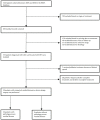Comparing Methods to Determine Complete Response to Chemoradiation in Patients with Locally Advanced Cervical Cancer
- PMID: 38201625
- PMCID: PMC10778528
- DOI: 10.3390/cancers16010198
Comparing Methods to Determine Complete Response to Chemoradiation in Patients with Locally Advanced Cervical Cancer
Abstract
Objectives: There is no consensus on the most reliable procedure to determine remission of cervical cancer after chemoradiotherapy (CRT). Therefore, this study aims to assess the diagnostic performance of two different imaging techniques, MRI and 18F[FDG]-PET/CT, in determining the presence of locoregional residual disease after CRT in patients with locally advanced cervical cancer.
Methods: Patients diagnosed with locally advanced cervical cancer (FIGO 2009) treated with CRT were retrospectively identified from a regional cohort. The accuracy of MRI and 18F[FDG]-PET/CT in detecting locoregional residual disease was assessed with histology as the reference standard.
Results: The negative predictive value (NPV) and positive predictive value (PPV) for locoregional residual disease detection of MRI and 18F[FDG]-PET/CT combined were 84.2% (95% CI 73.2-92.1), and 70.4% (95% CI 51.8-85.2), respectively. The NPV and PPV of MRI alone were 80.2% (95% CI 71.2-87.5) and 47.7% (95% CI 35.8-59.7), respectively, and values of 81.1% (95% CI 72.2-88.3) and 55.8 (95% CI 42.2-68.7), respectively, were obtained for 18F[FDG]-PET/CT alone.
Conclusion: In this study, the reliability of MRI and 18F[FDG]-PET/CT in detecting locoregional residual disease was limited. Combining MRI and 18F[FDG]-PET/CT did not improve predictive values. Routine use of both MRI and 18F[FDG]-PET/CT in the follow-up after CRT should be avoided. MRI during follow-up is the advised imaging technique. Pathology confirmation of the presence of locoregional residual disease before performing salvage surgery is warranted.
Keywords: 18F[FDG]-PET/CT; MRI; chemoradiotherapy; locally advanced cervical cancer; radiologic imaging; residual disease; salvage surgery; survival.
Conflict of interest statement
The authors declare that there are no conflicts of interest.
Figures
References
-
- Sung H., Ferlay J., Siegel R.L., Laversanne M., Soerjomataram I., Jemal A., Bray F., Bsc M.F.B., Me J.F., Soerjomataram M.I., et al. Global Cancer Statistics 2020: GLOBOCAN Estimates of Incidence and Mortality Worldwide for 36 Cancers in 185 Countries. CA A Cancer J. Clin. 2021;71:209–249. doi: 10.3322/caac.21660. - DOI - PubMed
-
- Cibula D., Pötter R., Planchamp F., Avall-Lundqvist E., Fischerova D., Meder C.H., Köhler C., Landoni F., Lax S., Lindegaard J.C., et al. The European Society of Gynaecological Oncology/European Society for Radiotherapy and Oncology/European Society of Pathology Guidelines for the Management of Patients With Cervical Cancer. Int. J. Gynecol. Cancer. 2018;28:641–655. doi: 10.1097/IGC.0000000000001216. - DOI - PubMed
-
- Sturdza A., Pötter R., Fokdal L.U., Haie-Meder C., Tan L.T., Mazeron R., Petric P., Šegedin B., Jurgenliemk-Schulz I.M., Nomden C., et al. Image guided brachytherapy in locally advanced cervical cancer: Improved pelvic control and survival in RetroEMBRACE, a multicenter cohort study. Radiother. Oncol. 2016;120:428–433. doi: 10.1016/j.radonc.2016.03.011. - DOI - PubMed
LinkOut - more resources
Full Text Sources
Research Materials


